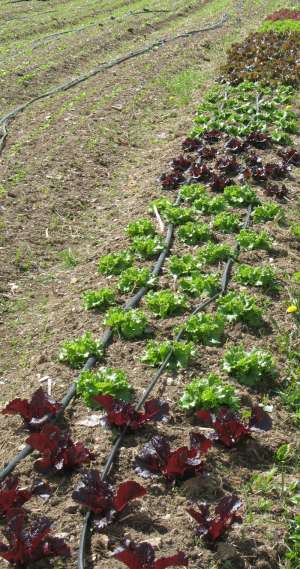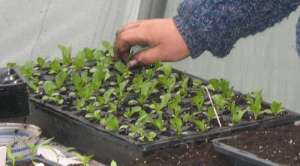 Let-tuce Begin
Let-tuce Begin
by Lois Labbe
(Click on photos to enlarge.)
Iceberg used to be the only lettuce we ate when I was younger—little did I know!!!!
At our farm, we grow over a dozen varieties which we are always changing, to try to improve
the quality, harvest window, and marketability. How well the variety holds up at market is one
key to growing for market. There are several varieties we have stopped growing because they
are too tender to bring to market, although they make a perfectly fine lettuce for the home
gardener. Of course the ultimate goal is to have it sell so fast that the hot sun or wind will
not have a chance to take its toll. But in the real world of Farmers' Markets, that does not
always happen.
I try to grow a range of varieties: romaines, buttercrunches, bibbs, even an iceberg type
which forms a nice little head. You also have color, the range of which is tremendous:
freckles, light red, dark red, greens, burgundy colored. The textures are all different as
well, very tender such as a buttercrunch, or more substantial like a romaine. Furthermore,
there are leaf types, which range smooth, frilly, oak leaf, etc. So it is not just a matter of
lettuce anymore.
The next step is to decide which types do better in our diverse and challenging growing
season. There are types that grow well early or late in the cool seasons but do not tolerate
the heat of July and August. These also vary widely and it can get quite confusing as the
season progresses. If you want to keep a steady supply, lettuce needs to be started every
seven to ten days, with several varieties in each planting. If the plantings overlap that's
alright, usually they do, at least that's the plan. When a lettuce starts to get past its
prime, it is better to turn it under then try to sell it because it becomes bitter.
Lettuce is very forgiving, and if you properly select your varieties it can recover from
freezing solid, and will stand up well in the heat of July—it all depends upon the
variety. If you make succession plantings, the bolting from the heat won't be a problem. You
can start it early in the season and very late in the season. I will usually start lettuce in
flats in March for transplanting out when the ground is thawed and prepared. Then we plant all
season long into September. Direct seeding begins as soon as the ground can be prepared which
of course varies with the weather, the ultimate goal is to have lettuce to start the early
Markets. We are also planting in our greenhouses in the ground. This works until it gets to
hot, for then it starts to bolt quickly. You can tell when lettuce is bolting. When it is cut
it will have a milky substance coming from the cut stem. Also, the plant will start to get
taller and the leaves will start to separate forming a very pretty tree from three to five
feet tall.
 Read the variety descriptions, to find out what variety does the best in each kind of
weather. The next step is to figure out how much lettuce you want to plant and how often. If
you have a very large family and neighbors who appreciate fresh lettuce, then you can do a
large planting every 10 days or so. It can either be direct seeded or transplanted, spacing is
not terribly critical, because, as the lettuce begins to grow, you can thin to single
lettuces, and use the baby lettuce in salads, etc.
Read the variety descriptions, to find out what variety does the best in each kind of
weather. The next step is to figure out how much lettuce you want to plant and how often. If
you have a very large family and neighbors who appreciate fresh lettuce, then you can do a
large planting every 10 days or so. It can either be direct seeded or transplanted, spacing is
not terribly critical, because, as the lettuce begins to grow, you can thin to single
lettuces, and use the baby lettuce in salads, etc.
For transplanting, I plant lettuce in 72 cell trays, then as it emerges I thin to one plant
per cell (above photo). I use the thinned lettuce to make up 6-paks to sell at market or another 72 cell
tray for us to transplant. So this is also something to consider, let the farmer do most of
the work and buy seedlings.
 Another way of growing lettuce, which has become very popular, is to grow a lettuce mix. With
this style you don't need to worry about thinning or transplanting or variety. The packets are
all made up by the seed company. Most have ten or more varieties including reds, greens,
ruffles and so on. These are often referred to as “cutting lettuces” in the catalog . They can
be harvested two to three times before they start to bolt. So if you planted every two to
three weeks during the summer, you can have a fresh supply of salad greens all season. This is
also good because you can plant in anything if you don't have a lot space. It can be planted
in a window box or in the ground. It does very well if it is crowded, so, as I mentioned
before with direct seeded lettuce, spacing is not a problem.
Another way of growing lettuce, which has become very popular, is to grow a lettuce mix. With
this style you don't need to worry about thinning or transplanting or variety. The packets are
all made up by the seed company. Most have ten or more varieties including reds, greens,
ruffles and so on. These are often referred to as “cutting lettuces” in the catalog . They can
be harvested two to three times before they start to bolt. So if you planted every two to
three weeks during the summer, you can have a fresh supply of salad greens all season. This is
also good because you can plant in anything if you don't have a lot space. It can be planted
in a window box or in the ground. It does very well if it is crowded, so, as I mentioned
before with direct seeded lettuce, spacing is not a problem.
Lettuce grows from the center. So when harvesting try not cut too close and it will give
you two or three cuttings on a single planting. You can also just pick off the outside leaves.
When planting lettuce, the things to remember are; lettuce seed needs light to germinate so
sprinkle seed on top of medium, tamp seed into soil and cover lightly. If you are top
watering, be careful not to wash the seed away. We place our flats in soaker trays, which are
available at most garden supply centers. Don't forget to water every few days, do not let the
soil dry out until seedlings emerge. It usually takes a week to ten days and it is harvested
when the leaves are two to three inches.
|
![[Snakeroot Organic Farm logo]](pix/sof.gif)





